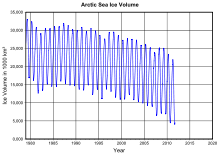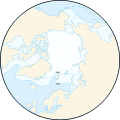- Sea ice
-
Sea ice is largely formed from seawater that freezes. Because the oceans consist of saltwater, this occurs below the freezing point of pure water, at about -1.8 °C (28.8 °F).
Sea ice may be contrasted with icebergs, which are chunks of ice shelves or glaciers that calve into the ocean. Icebergs are compacted snow and hence are fresh water from the beginning; sea ice loses its salt during its process of formation from sea water and thus eventually is fresh as well.
Contents
-
Satellite image of Fennoscandia in winter. The Gulf of Bothnia and White Sea are covered with sea ice.
-
Sea ice off Baffin Island.
-
Sea ice imitates the shoreline along the Kamchatka Peninsula.
-
Clear view of the Antarctic Peninsula, the Larsen Ice Shelf, and the sea ice covered waters around the region.
Types of sea ice
 Pancake ice is sea ice that has been compressed by the action of waves on frazil ice. Plates are typically 1 - 3 meters across.
Pancake ice is sea ice that has been compressed by the action of waves on frazil ice. Plates are typically 1 - 3 meters across.
Land-fast ice, or simply fast ice, is sea ice that has frozen along coasts ("fastened" to them) or to the sea floor over shallow parts of the continental shelf, and extends out from land into sea. Unlike drift ice, it does not move with currents and wind.
Drift ice consists of ice that floats on the surface of the water, as distinguished from the fast ice, attached to coasts. When packed together in large masses, drift ice is called pack ice. Pack ice may be either freely floating or blocked by fast ice while drifting past.
Pancake ice is sea ice broken into small round chunks looking like pancakes.
The most important areas of pack ice are the polar ice packs formed from seawater in the Earth's polar regions: the Arctic ice pack of the Arctic Ocean and the Antarctic ice pack of the Southern Ocean. Polar packs significantly change their size during seasonal changes of the year. Because of vast amounts of water added to or removed from the oceans and atmosphere, the polar ice packs experience a significant impact from global changes in climate; see "Polar ice packs" for details.
An ice floe is a floating chunk of ice that is less than 10 kilometers (six miles) in its greatest dimension. Wider chunks of ice are called ice fields.
Formation of sea ice
Main article: Sea ice growth processesOnly the top layer of water needs to cool to the freezing point. Convection of the surface layer involves the top 100 – 150 m, down to the pycnocline of increased density.
In calm water, the first sea ice to form on the surface is a skim of separate crystals which initially are in the form of tiny discs, floating flat on the surface and of diameter less than 2–3 mm. Each disc has its c-axis vertical and grows outwards laterally. At a certain point such a disc shape becomes unstable, and the growing isolated crystals take on a hexagonal, stellar form, with long fragile arms stretching out over the surface. These crystals also have their c-axis vertical. The dendritic arms are very fragile, and soon break off, leaving a mixture of discs and arm fragments. With any kind of turbulence in the water, these fragments break up further into random-shaped small crystals which form a suspension of increasing density in the surface water, an ice type called frazil or grease ice. In quiet conditions the frazil crystals soon freeze together to form a continuous thin sheet of young ice; in its early stages, when it is still transparent, it is called nilas. When only a few centimeters thick this is transparent (dark nilas) but as the ice grows thicker the nilas takes on a grey and finally a white appearance. Once nilas has formed, a quite different growth process occurs, in which water molecules freeze on to the bottom of the existing ice sheet, a process called congelation growth. This growth process yields first-year ice, which in a single season may reach a thickness of 1.5–2 m.
In rough water, fresh sea ice is formed by the cooling of the ocean as heat is lost into the atmosphere. The uppermost layer of the ocean is supercooled to slightly below the freezing point, at which time tiny ice platelets, known as frazil ice, form. As more frazil ice forms, the ice forms a mushy surface layer, known as grease ice. Frazil ice formation may also be started by snowfall, rather than supercooling.
Slush is a floating mass formed initially from snow and water. Shuga is formed in agitated conditions by accumulation of slush or grease ice into spongy pieces several inches in size.
Waves and wind then act to compress these ice particles into larger plates, of several meters in diameter, called pancake ice. These float on the ocean surface, and collide with one another, forming upturned edges. In time, the pancake ice plates may themselves be rafted over one another or frozen together into a more solid ice cover, known as consolidated ice pancake ice. Such ice has a very rough appearance on top and bottom.
Sea ice is largely fresh, since a lot of the ocean salt is expelled during ice formation. The resulting ice is riddled with minute brine-filled channels and consequently is still salty (about 1% salt, compared with about 3.5% salt in the ocean).[1] The expelled brine has an important bearing on the ocean circulation.
If sufficient snow falls on sea ice to depress the freeboard below sea level, sea water will flow in and a layer of ice will form of mixed snow/sea water. This is particularly common around Antarctica.
Russian scientist Vladimir Vize (1886–1954) devoted his life to study the Arctic ice pack and developed the Scientific Prediction of Ice Conditions Theory, for which he was widely acclaimed in academic circles. He applied this theory in the field in the Kara Sea, which led to the discovery of Vize Island.
Yearly freeze and melt cycle
 Seasonal variation and annual decrease of Arctic sea ice volume as estimated by measurement backed numerical modelling.[2]
Seasonal variation and annual decrease of Arctic sea ice volume as estimated by measurement backed numerical modelling.[2]
Sea ice freezes and melts due to a combination of factors, including the age of the ice, air temperatures, and solar insolation. During the winter the area of the Arctic Ocean covered by sea ice increases, usually reaching a maximum extent during the month of March. The area covered in sea ice then decreases, reaching its minimum extent in September most years. First-year ice melts more easily than older ice for two reasons: 1) First-year ice is thinner than older ice, since the process of congelation growth has had less time to operate; and 2) first-year ice is less permeable than older ice, so summer meltwater tends to form deeper ponds on the first-year ice surface than on older ice, and deeper ponds mean lower albedo and thus greater solar energy capture.
Monitoring and observations
Main article: Measurement of sea iceSatellite data has allowed the tracking of sea ice extents since 1978. During the warmest years, like the winter of 2005-2006, sea ice is observed to reach a winter maximum extent that is smaller than in the years before or after. The summer minimum Arctic ice extent for 2010 was the third lowest over the period of satellite observations of the polar ice. The minimum record summer Arctic sea ice extent was in 2007.[3]
Ecology
Main article: Sympagic ecologySea ice is part of the Earth's biosphere. When sea water freezes, the ice is riddled with brine-filled channels which sustain sympagic organisms such as bacteria, algae, copepods and annelids, which in turn provide food for animals such as krill and specialised fish like the Bald notothen, fed upon in turn by larger animals such as Emperor penguins and Minke whales.[4]
The decline of seasonal sea ice is putting the survival of Arctic species such as ringed seals and polar bears at risk.[5][6][7]
See also
- Arctic sea ice ecology and history
- Arctic shrinkage
- Drift ice station
- Drift station
- Ice class
- Ice pier
- Ice shelf
- Measurement of sea ice
- Polynya
- Sea ice concentration
- Sea ice growth processes
- Vladimir Wiese
- Zhubov scale
References
- ^ http://www.esr.org/outreach/glossary/sea_ice.html
- ^ Zhang, Jinlun and D.A. Rothrock: "Modeling global sea ice with a thickness and enthalpy distribution model in generalized curvilinear coordinates", Mon. Wea. Rev. 131(5), 681-697, 2003.
- ^ Scott, Michon. "Arctic Sea Ice Minimum for 2010". NASA Earth Observatory. http://earthobservatory.nasa.gov/IOTD/view.php?id=46282. Retrieved 6 October 2010.
- ^ http://www.acecrc.sipex.aq/access/page/?page=d664da82-b244-102a-8ea7-0019b9ea7c60
- ^ Barber, D.G.; Iacozza, J. Historical analysis of sea ice conditions in M'Clintock Channel and the Gulf of Boothia, Nunavut: implications for ringed seal and polar bear habitat. Arctic 57(1) Mar. 2004, pp. 1–14.
- ^ Stirling, I.; Lunn, N.J.; Iacozza, J.; Elliott, C.; Obbard, M. Polar bear distribution and abundance on the southwestern Hudson Bay coast during open water season, in relation to population trends and annual ice patterns. Arctic 57(1) Mar. 2004, pp. 15–26.
- ^ Stirling, I.; Parkinson, C.L. Possible effects of climate warming on selected populations of polar bears (Ursus maritimus) in the Canadian Arctic. Arctic 59(3) Sept. 2006, pp. 261–275
- Rothrock, D.A. and J. Zhang (2005). "Arctic Ocean Sea Ice Volume: What Explains Its Recent Depletion?". J. Geophys. Res. 110 (C1): C01002. Bibcode 2005JGRC..11001002R. doi:10.1029/2004JC002282.
- "How Does Arctic Sea Ice Form and Decay?". NOAA Arctic theme page. http://www.arctic.noaa.gov/essay_wadhams.html. Retrieved April 25, 2005.
- "NSIDC Sea ice". All About Sea Ice. http://nsidc.org/seaice/. Retrieved October 6, 2005.
- Konstantin Y. Vinnikov, Donald J. Cavalieri, and Claire L. Parkinson, V33, L05704, A model assessment of satellite observed trends in polar sea ice extents.
External links
- NOAA Arctic theme page
- Ice in the Sea Chapter from Nathaniel Bowditch's American Practical Navigator
- Cryosphere Today: Current Arctic sea ice conditions
- Data source for sea ice picture
- Marine Modeling and Analysis Branch
- Everything you ever wanted to know about sea ice but were afraid to ask
- NSIDC Sea Ice Index
- Global Sea Ice Extent and Concentration: What sensors on satellites are telling us about sea ice
- BBC News, 28 September 2005, "Arctic ice 'disappearing quickly'"
- German remote-sensing sea ice group including high-resolution ice maps.
- Video that depicts the formation of sea ice in the Baltic sea
- The Arctic ice sheet True color map, daily updates during summer.
Categories:- Earth phenomena
- Aquatic ecology
- Sea ice
- Glaciology
Wikimedia Foundation. 2010.






